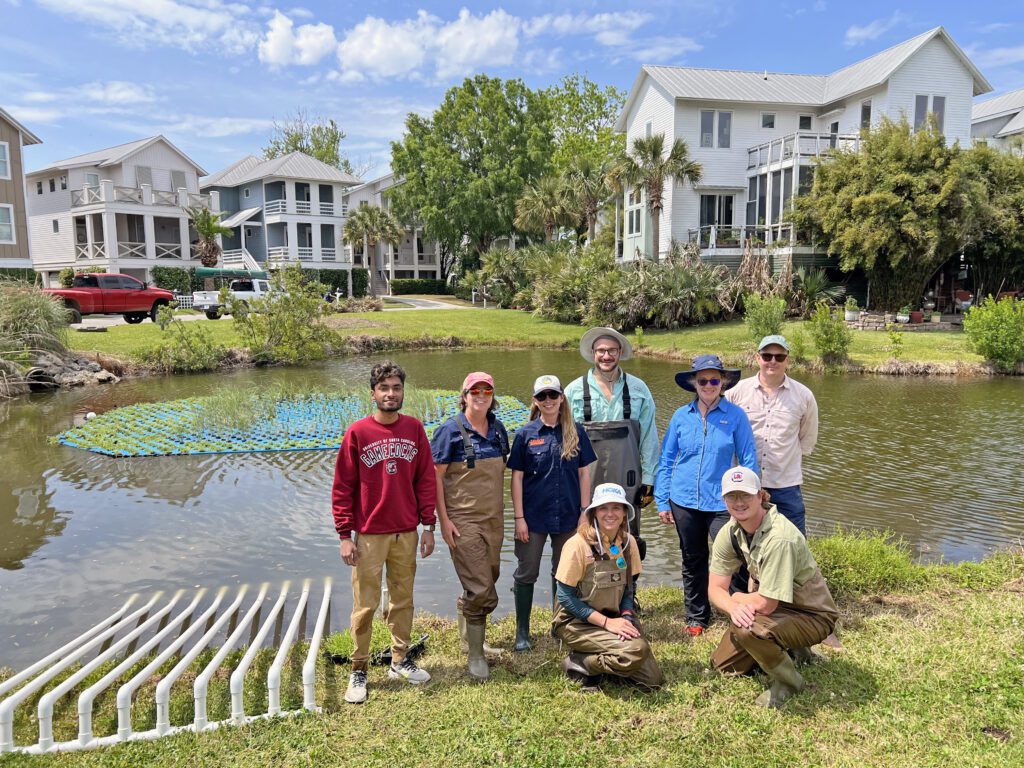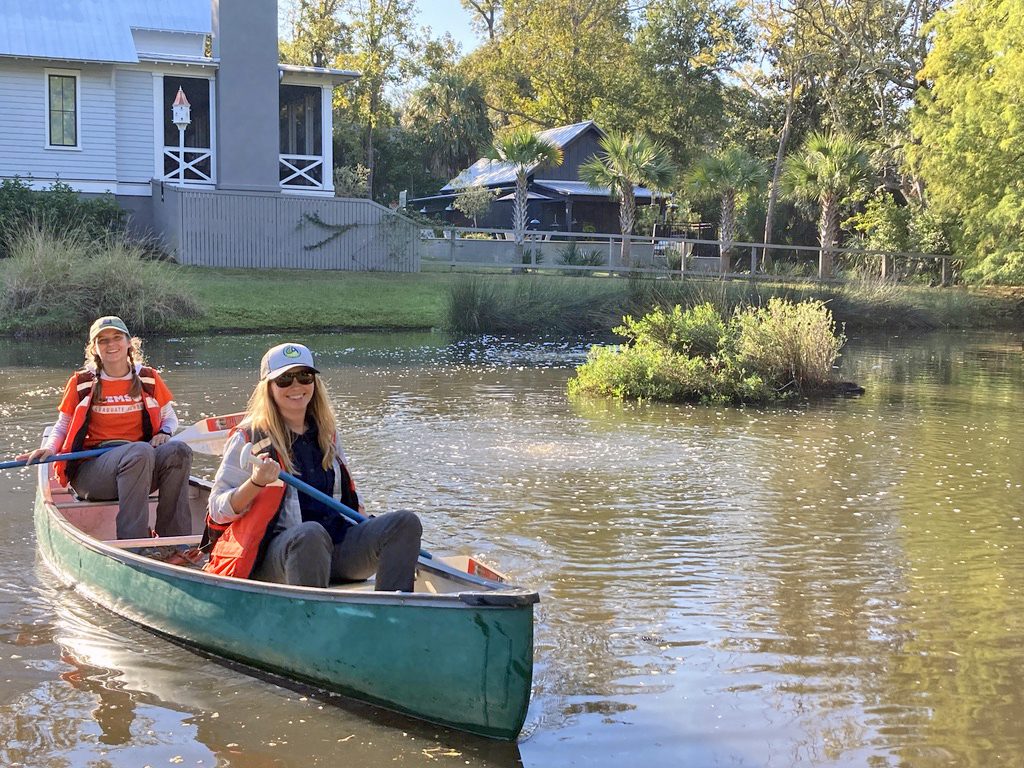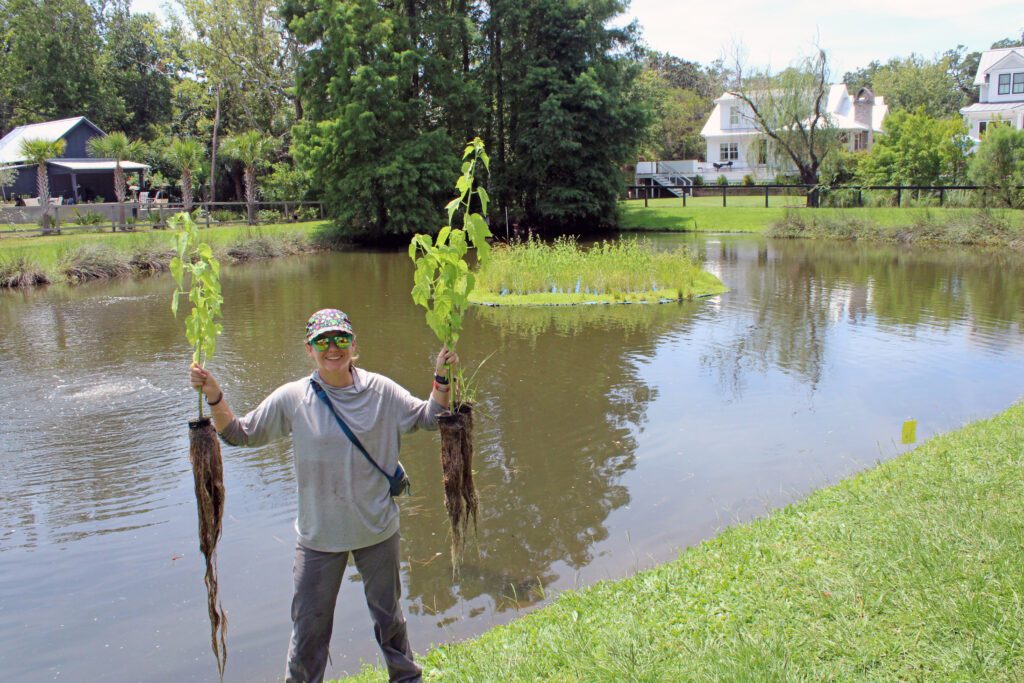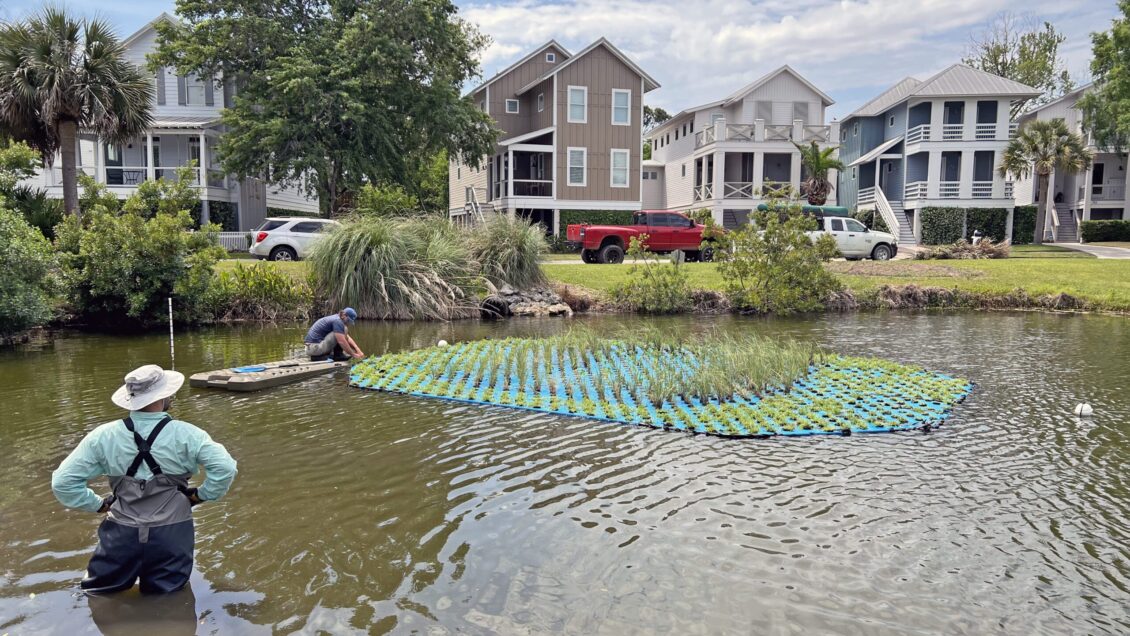Clemson research, Extension helping protect water quality, property value through ‘supercharged’ stormwater ponds
Natural wetlands are a defining feature of South Carolina’s coast, where the creeks, marshes, rivers and beaches make for a picturesque setting with bountiful recreation.
But any observer of the state’s coastal landscape over the last quarter-century is sure to have noticed the proliferation of stormwater ponds — a direct result of regulations placed on new developments in the 1990s to manage runoff due to increased impervious surfaces — and most new housing developments include at least one.
Stormwater ponds are the primary best management practice used to comply with stormwater control requirements … which makes them an increasingly prominent feature of the landscape, too, as South Carolina’s nine coastal counties have more than 20,000 created ponds.
Since that number seems certain only to rise, Clemson University researchers and Cooperative Extension professionals are working to make the ponds as effective and attractive as possible.
And when it comes to those two things, Assistant Professor of Watershed Management Amy Scaroni says floating wetlands, essentially container gardens on the surface of ponds and lakes, are an especially effective tool for both.
“If you already have a stormwater pond, it might be doing the best it can to treat water quality, but research is showing we can make it do an even better job if we add these floating wetlands,” Scaroni said. “And guess what? You don’t have to give up any of your land, it doesn’t affect the volume of water in the pond because it floats, and it essentially supercharges the stormwater pond.”
Floating wetlands use plants native to South Carolina and have a remarkable ability to manage pollution and improve the waterbody’s appearance.
The cool thing about floating wetlands is you can put them in an existing pond without doing much else and get additional benefits.
AMY SCARONI, CLEMSON Assistant Professor of Watershed Management
‘A REPUTATION AS POWERHOUSES’
Sarah White, Clemson University professor of water quality and treatment, has worked on the floating treatment of wetlands for more than 15 years and recalls quickly being struck by the simplicity of putting plants on water and cleaning the water while growing a saleable crop.
But while her initial idea was to use floating wetlands as a secondary production area on land typically unusable for growers, White soon realized the more practical applications were on a smaller scale, such as stormwater ponds.

“And we try to make them pretty,” White said. “We try to pick plants that have flowers or have some other purpose. Now, some industrial professionals who work on large projects — tens of thousands of square feet — say that plants without flowers do the best job cleaning water. But if you want to make homeowners happy, you make it look more like a floating garden.”
And what happens once you have a floating garden on a pond?
Floating wetlands provide for a diverse pond habitat, and the recommended native plants help promote food and shelter for fish, amphibians, pollinators, wading birds and other pond visitors.
The new ecosystem created is a byproduct of enhancing the water quality and providing habitat for fish, shrimp and other critters at the bottom of the seafood chain.
“They also have a reputation as powerhouses in water quality treatment: a combination of plant uptake, microbial activity along a dense, floating root system and sedimentation help to remove pollution from pond water,” White said.
The concept of a floating wetland sounds relatively simple. Still, within the scientific community, there is plentiful potential yet to be unlocked as each new answer sets off a chain reaction of more complex questions.
“How does insulation of floating wetlands and the root systems in the water enhance their chances of survival? How can we help support the food web and pollinators? Then there’s the microbial communities, which scientists are getting really excited about,” White said. “There’s a lot of hope in the future for taking this information and applying it to enhance pollutant removal from ponds.”
REACHING OUT
While White and other researchers pursue those answers through this research — one pillar of Clemson’s land-grant mission — others are working hard to bring the existing research-based science to the people of South Carolina.
That’s the outreach pillar of Clemson’s land-grant mission, and where the Clemson Cooperative Extension Service takes the reins.

A floating wetland was installed and another harvested during a workshop for residents and municipal partners last year in Mount Pleasant, South Carolina, to demonstrate the process of removing one and replanting the plants along the shoreline to create an additional buffer against shoreline erosion.
Scaroni, part of the Clemson Extension Water Resources Program Team, said the workshop was a perfect example of Clemson’s research and Extension missions working together in harmony.
“Even before it’s finished, this research project is directly sharing information out to the people of South Carolina,” Scaroni said.
And it’s certainly needed now. A boom in coastal development has brought with it expansion of impervious surfaces, such as rooftops and roads, and in turn, larger runoff volumes and higher peak flows from rain events.
The stormwater ponds receive polluted stormwater runoff and act as settling basins to improve water quality before it flows out of the pond to a creek, stream or ocean.
But there is a problem: You’re left with a pond that potentially has poor water quality — which isn’t something most people want in their neighborhoods.
“When you’re introducing all these excess nutrients and you end up with algal blooms, it’s now unsightly,” Scaroni said. “People don’t want their pond to look like it has poor water quality — even though that’s essentially a goal of these ponds in the first place: to manage pollution so that it doesn’t reach our natural water bodies. So, we’ve had to start caring a little more about what ponds look like and not just how well they work.”
THE NEXT STEPS
Clemson and the University of South Carolina installed floating wetlands at three ponds in Mt. Pleasant as part of the research project to better understand how to successfully install and maintain floating wetlands in these brackish coastal ponds.
Doctoral student Clare Escamilla is working on stormwater ponds in the Lowcountry, where much of the water is brackish, or a mixture of saltwater and freshwater, meaning that some plants used in stormwater ponds with freshwater, would not survive.
Thus, the first portion of Escamilla’s research is making an inventory of viable plant options. Next, she wants to determine which options South Carolinians, homeowners’ associations and property managers find most appealing — and therefore are more likely to install — and has met with focus groups in dense urban areas such as Charleston, Myrtle Beach and Beaufort.
“During my fieldwork, we see people out enjoying the ponds, so we know the ponds are important features in their community,” Escamilla said. “We want to make sure the plants are something they want in their ponds. At the end of the day, if they don’t like how it looks, they’re not going to put it in.”

Escamilla’s poster presentation on the project placed first at the South Carolina Water Resources Conference, her video abstract took third place among research projects from the Clemson Graduate Student Government, and she won the 3-minute thesis competition at the CAFLS graduate research symposium.
White and Bill Strosnider, director of the University of South Carolina’s Baruch Marine Field Laboratory, co-chaired a session on floating treatment wetlands at an international conference in Australia last year. Scaroni and Escamilla also made the trip to give presentations on the research.
“I shared some of the research that I did with residents, and conference attendees who work with floating wetlands in other countries had a lot of similar feelings and sentiments when they put wetlands in public places — they want the water quality benefits, but not at the sacrifice of how it looks,” Escamilla said.
As a Ph.D. student in Clemson’s Department of Plant and Environmental Sciences, Escamilla’s work also brings in the third pillar of Clemson’s land-grant mission — along with research and outreach — which is education.
White said the significance of Escamilla’s research as a graduate student is evident in their success with every installation of a floating wetland.
“The last thing you want is to put plants in a floating wetland and all the plants die because we don’t know the water quality is,” White said. “So, Clare’s work is basically helping us develop a selection tool for plants.”
Escamilla said that all South Carolinians are invited to participate in an online survey to identify possible concerns about ponds in coastal communities.
“We want to understand how residents feel about their current community stormwater ponds and if the ponds currently experience any water quality concerns,” she said.
Get in touch and we will connect you with the author or another expert.
Or email us at news@clemson.edu

